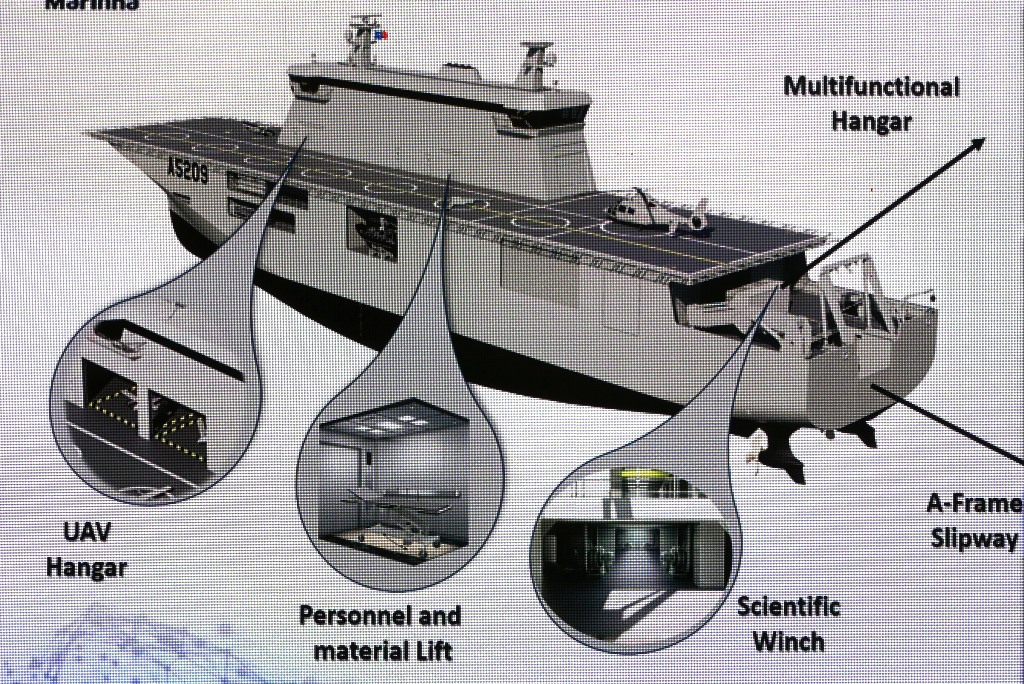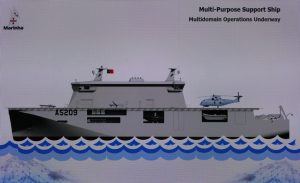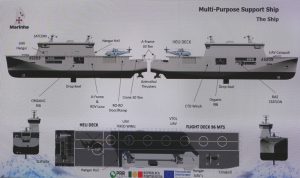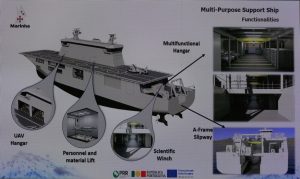
DIMDEX 2024 – The Portuguese Navy details its future Multi-Purpose Support Ship (MPSS) design
During the DIMDEX 2024 exhibition, the Portuguese Navy Chief of Staff , Admiral Henrique Eduardo Passálaqua de Gouveia e Melo, presented the innovative Multi-Purpose Support Ship (MPSS) design that was developed by Damen Shipyards on the specific requirements of his Service
The contract for the design, construction and outfitting of the MMPS by Damen Shipyards was signed in November 2023, and the ship has been assigned the name D. João II (A 5209). Delivery is planned for the first half of 2026.

“The MMPS has been a personal dream, which developed from my experience in the anti-submarine warfare as submariner (and commanding officer) and anti-air and anti-surface warfare as frigate commander,” said Admiral Gouveia e Melo. Combining these experiences, the today Chief of Staff finalized the concept of an innovative multi-purpose ship capable to operate unmanned systems as well as conducting, thanks to its versatility and reconfigurable capabilities, a wide type of missions. These range from the collection of environmental data in Portuguese waters, exclusive economic zone (EEZ) and their seabed, to disaster relief, search and rescue and support of civil security authorities, and defence. In the latter case to conduct sovereignty missions in Portuguese waters and EEZ, as well as surveillance and maritime security, seabed warfare, amphibious and evacuation missions.
The capabilities offered by the flight deck and embarked package of unmanned air, underwater and surface vehicles provide a significant wider coverage compared to legacy combatant platforms such as frigates, while the multi-mission bay with slipway and side RO-RO ramp, associated to the capability of accommodating landing crafts and RHIBs, as well as the drop keel for the scientific equipment deployment, provides the means to effectively conduct different missions with a single platform, the Chief of Staff explained.
The platform
With a displacement of 7,000 tonnes, an overall length and beam of respectively 107 and 20 metres, and a draft of 5.5 metres, the MMPS is characterized by a flight deck 96 metres long and wide as the ship beam with a long island on the starboard side, the remaining stern open area being dedicated and equipped to support the afloat and shore-based operations through the rear slipway and side ramp.
The side island accommodates the main bridge, command and control, and rear flight operations control station, alongside a long unmanned system hangar on the flight deck side and a stern 10 tonnes helicopter hangar together with maintenance and other facilities.
The propulsion package includes two main azipod propellers driven by an undisclosed number of diesel generators for a propulsion power of over 6 MW according to Damen documentation, providing a maximum and cruise speeds of respectively 18 and 14 knots, with an operational endurance of 45 days. Thanks to the diesel-electric propulsion with azipod propellers, admiral Gouveia e Melo believes to have the best compromise between operational speed, consumption, endurance and future operational and environmental protection requirements.

Thanks to its two azipods and a bow-mounted azimuthal thruster, the MMPS is characterized by high manoeuvrability, which allows the MMPS to operate in constrained waters. The new ship is also equipped with a Dynamic Positioning System 1 (DPS 1) allowing the platform to conduct a range of operations, from scientific to mine countermeasures. It is equipped with a roll reduction system, ensuring operations in high sea states with unmanned and manned air, surface and underwater platforms.
Total generation power is expected to exceed 8 MW with fumes discharging fitted with a Tier III gas emission reduction system. According to the shipbuilder and customer, thanks to its versatility, the ship could be also equipped in the future with batteries ensuring power to ship systems without gas emissions. It is also equipped with a replenishment at sea (RAS) starboard receiving station for liquids, such as fuel and water, and solids up to 250 kg.
With a ship availability of up to 250 days per year and a North/South 60° latitude operations (no ice), the MMPS has accommodations for up to 100 persons including a 48 units crew and the remaining for scientific and UXV operations. Temporary accommodations could allow to embark 100 passengers while, with living modules, the ship can carry 200 additional persons. Hospital facilities includes a surgical room, a recovery room with 4 beds, pharmacy and other medical facilities.

In addition to the stern slipway for unmanned surface and underwater vehicles, RIHB, landing crafts, the MMPS is equipped with a lateral RO-RO ramp on the port side for embarking and disembarking land vehicles. To support these operations, the stern slipway is equipped with a 30 tonnes launch and recovery system and supported by a 30 tonnes lateral crane positioned on the port side.
Scientific missions require the MPPS to be equipped with a keel drop and laboratories managed by up to 42 scientists.
No indications have been provided on ship armament, neither the presentation highlighted any weapon system.
MMPS main missions and equipment
To conduct a variety of different missions, the MMPS comes with a command, control and communications suite with data links and SATCOM, managing a sensors package including a 2D air/naval surveillance radar and EO/IR systems, according to the ship’s integrated capabilities presentation slide. A key feature of the new ship is the level of automation and digitalization that includes a digital twin and artificial intelligence (AI), capable to collect a wider range of data not only for operational but also for maintenance and logistic support.

As anticipated, the MMPS will act as a platform for a wide range of air, surface and underwater operations thanks to its unobstructed flight deck featuring seven take-off and landing spots on the lateral runway, a catapult station in front of the lateral island, and a stern flight deck spot for a 15 tonnes AW101 helicopter.
Being managed by a rear island flight control operations centre, the MMPS can embark rotary-, fixed-wings and hybrid propulsion UASs with an overall maximum take-off weight of two tonnes, the Chief of Portuguese Navy said, alongside helicopters up to 15 tonnes, but permanent recovery is ensured only for an NH90 type aircraft. The internal main bay can accommodate both unmanned surface (USVs) and underwater vehicles (UUVs), which can be deployed mainly by the stern slipway and crane. The Chief of Staff hasn’t elaborated on the type and number of unmanned systems embarked, but according to the presentation provided by the head of the Directorate of Ships Rear Admiral Antonio F. Mateus during the Navy Tech 2024 conference and exhibition in Tallinn last February, the MMPS will operate unmanned platforms developed by Portuguese universities, research centres and industry.
In addition to the drop keel for scientific duties, the MMPS is equipped with a lateral station on the port side for a Luso scientific remotely operated vehicle (ROV) and a conductivity, temperature and depth sonde with winch on a starboard side station, alongside scientific winches under the main bay deck.
Expeditionary, amphibious and disaster relief missions required the ship to be equipped with an internal elevator for both personnel and materiel transfer from the flight to under decks, a main transportation bay deck area capable to accommodate alternatively and depending on the assigned mission, up to 18 20-feet containers or 18 light vehicles, or seven additional RHIBs and three landing crafts, which can be embarked with a RO-RO ramp on the ship port side or slipway and side crane.
Materiel and vehicles are transferred ashore by two 10 meters long landing crafts operating from the ship side stations, and two 7.5 meters RIHBs for maritime security, transportation and tendering also from the two lateral stations. As anticipated, in addition to the crew and specialists, the MMPS can temporarily accommodates up to 100 persons plus additional 200 thanks to containerized accommodations located on the deck area.
The project followed a European tender process and is funded by the European Union’s Recovery and Resilience Facility (RRF) that is part of NextGenerationEU (the economic recovery package to support EU member states affected by the COVID-19 pandemic).
Damen Shipyards today proposes a family of MMPS platforms, which 7000 tonnes design has been co-developed with the Portuguese Navy, the vessel’s launching customer. The MMPS range, featuring 7000 and 9000 tonnes versions, combines the vision of the Portuguese Navy, with Damen’s proven process of shipbuilding, using standardised solutions wherever possible.

